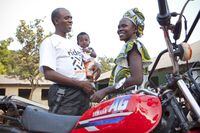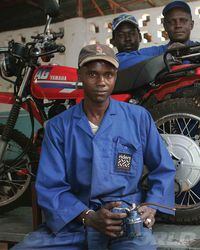People who ride motorcycles and scooters in what used to be called the First World purely for recreation too easily forget that their "toys" are first and foremost transportation devices. But people in the Third World use any motorized conveyance to replace Shank's Mare or real mares for getting around and doing essential tasks—such as, for example, rushing snakebite victims in Nepalto regional hospitals, as made clear in a recent ScienceNews story.
The same dynamic qualities built into powered two-wheelers (transportation technocrats call any motorcycle, scooter or moped a “Powered Two-Wheeler” or PTW) that make them fun for First Worlders also make them important transportation in places where road infrastructure is skimpy or non-existent, and where road “rules” are likewise minimally attended to. When disaster strikes, a PTW can slip through gridlock, around and over obstacles and, in short, go places where not even the toughest 4x4 can go. And do it all on very little fuel.
The ScienceNews story makes it clear that the bikes were only part of the solution; people had to accept that dealing with snakebites by going to "traditional" healers—snake charmers and the like—was even more important. But even so, without the ability to get snakebite victims to help quickly, the victims would almost certainly die.
Official use of PTWs in our society tends to be limited to police and highway patrols, but the encouraging news from Nepal’s PTW riders suggests that we should not forget what motorcycles can do that cars cannot when seconds count in saving lives.


/cloudfront-us-east-1.images.arcpublishing.com/octane/A4EN3OE2HRBXVFICJ6K62CNXCM.jpg)
/cloudfront-us-east-1.images.arcpublishing.com/octane/ZBLIY3XNQ5ACNNJ65IL44KBZAE.jpg)
/cloudfront-us-east-1.images.arcpublishing.com/octane/HDO56KGQB5H25DJRM2J2PH2E5A.jpg)
/cloudfront-us-east-1.images.arcpublishing.com/octane/NZKPFUWBHVGYJAFQPCXWAK6BZM.jpg)
/cloudfront-us-east-1.images.arcpublishing.com/octane/K5ZSQFMYQZHWRFXTTW4PEWMUDM.jpg)
/cloudfront-us-east-1.images.arcpublishing.com/octane/D2SOSBIQQRBPTERNSOJRAW3KYY.jpg)
/cloudfront-us-east-1.images.arcpublishing.com/octane/DS3Q5X2VJFFAJDK2PWB3Y7K6U4.jpg)
/cloudfront-us-east-1.images.arcpublishing.com/octane/4KBL4JAMYRFDPEINTWATDUH7OM.jpg)
/cloudfront-us-east-1.images.arcpublishing.com/octane/FXADK3MVSNBRTKJ2B7TPDCCJ5Y.jpg)
/cloudfront-us-east-1.images.arcpublishing.com/octane/M7L2CPXO55FRFMECW7QGDPGP6E.jpg)
/cloudfront-us-east-1.images.arcpublishing.com/octane/T4RWGLAEHVE2VCJZOTFTNGB2KA.jpg)
/cloudfront-us-east-1.images.arcpublishing.com/octane/JM4QGLAHWNGHPM74OEB7FVBFSY.jpg)
/cloudfront-us-east-1.images.arcpublishing.com/octane/BGPNXPDDYBHD3HL6YEZQOYHXTI.jpg)
/cloudfront-us-east-1.images.arcpublishing.com/octane/SND5GGQV4RDPPMZBSBEGIZ4SIY.jpg)
/cloudfront-us-east-1.images.arcpublishing.com/octane/XUDDAPYZMZEL5EDPVDJ2DTULWI.jpg)
/cloudfront-us-east-1.images.arcpublishing.com/octane/M7AU2L6GAVCJVHW57LIRPDAAUQ.jpg)

/cloudfront-us-east-1.images.arcpublishing.com/octane/JKEJY7P43JGD5C5NJO2VJQJPUM.jpg)
/cloudfront-us-east-1.images.arcpublishing.com/octane/YROKYJYUQVGPHCEMPTGBWDQCKQ.jpg)
/cloudfront-us-east-1.images.arcpublishing.com/octane/QIHEYR66TZDAPCGMWHCWCBC4XA.jpg)
/cloudfront-us-east-1.images.arcpublishing.com/octane/4FTBMNZL5BD2ZHY62XXRHJW6PI.jpg)
/cloudfront-us-east-1.images.arcpublishing.com/octane/L2BHKRCEMFDF7O3S4REZXPDH2E.jpg)
/cloudfront-us-east-1.images.arcpublishing.com/octane/QHENIV3HMJCTTCXQ6O5YPTNRZ4.jpg)
/cloudfront-us-east-1.images.arcpublishing.com/octane/K3VNQBIAKVGIHIGBRG7QKJYLVI.jpg)